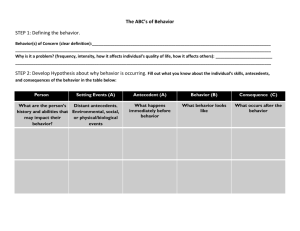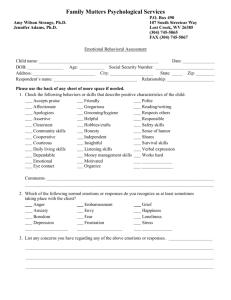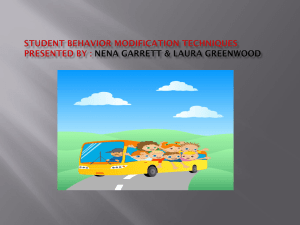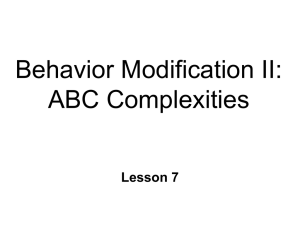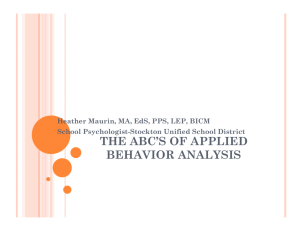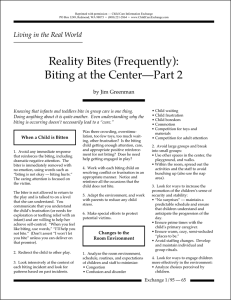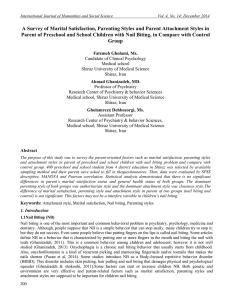Self-Directed Behavior Modification Project
advertisement
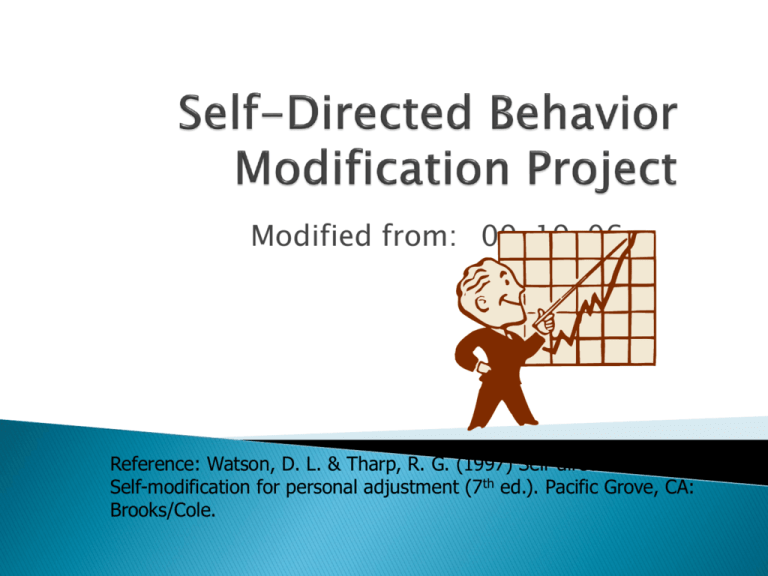
Modified from: 09-19-06 Reference: Watson, D. L. & Tharp, R. G. (1997) Self-directed behavior: Self-modification for personal adjustment (7th ed.). Pacific Grove, CA: Brooks/Cole. Specific behavior to be changed (concrete and observable) Specific situations in which the behavior occurs Choose a behavior that you are motivated to change. Short-term vs. long-term goals 1. 2. 3. 4. Make a list of concrete examples. List the details of your problem. Become an observer of yourself. Your strategy should always be to increase some desirable behavior. My goal is _________________ (what you want to do) when_____________________. (the situation) I want to quit goofing off and study more; or I want to increase studying in those situations in which I should study. 5. Specify the chain of events that will lead to your goal. 6. Observe other people who are successful at what you are trying to do, and then try their tactics yourself. 7. Think of alternative solutions. Expect mistakes. Don’t blame mistakes on your personality. Prepare for temptations. Antecedents Behavior Consequences Antecedents Behaviors – Consequences When did it happen? Whom were you with? What were you doing? Where were you? What were you saying to yourself? What thoughts were you having? What feelings were you having? What were you saying to yourself? What thoughts did you have? What feelings were you having? What actions were you performing? What happened as a result? Was it pleasant or unpleasant? actions, thoughts, or emotions Antecedents Behaviors Consequences Waiting for the bus Nail biting Sitting in class Lying in bed thinking Reading Stressed Nail Nail Nail Nail Embarrassed that others might see Same Just wish I would quit Same Gives me something to do biting biting biting biting Antecedents Behaviors – April 3. Saturday morning at breakfast. I spanked both of Made them even more them. cross. Kids argued a lot. April 6. Came home from work feeling tired. My boy talked back to me. April 10. Had an argument with my wife. Then in the car the kids started quarreling. Started to spank him but stopped. Grounded him for an hour instead. Spanked them – actually slapped them. Consequences Felt pretty good about that. Was glad I didn’t hit him. He calmed down while he was grounded. It spoiled our whole outing. I felt guilty. They felt rotten. feeling stressed spanking feeling bad kids’ misbehavior But if instead: substitute kids’ misbehavior punishment (no spanking) feeling good Number of cookies per day Number of text messages per day Minutes studying per day Number of days jogging per week Number of times biting nails per day Hours slept per night Money spent on junk food per day 1. 2. 3. 4. Do the counting when the behavior occurs, not later. Be accurate and strict in your counting. Try to include all instances of the behavior. Keep written records. Keep the recording system as simple as possible. Try to fit it into your usual habits. Throughout life, regulation by others and the self (particularly through verbal instructions) acts as a powerful guide to behavior. Operant behavior is a function of its consequences. A positive reinforcer is a consequence that maintains and strengthens behavior by its added presence. A negative reinforcer is a consequence that strengthens behavior by being subtracted from the situation. Behavior that is punished will occur less often. An act that was reinforced but no longer is will begin to weaken. Intermittent reinforcement increases resistance to extinction. Most operant behavior is eventually guided by antecedent stimuli, or cues, the most important of which are often self-directed statements. An antecedent can be a cue or signal that an unpleasant event may be imminent. This is likely to produce avoidance behavior. Through conditioning, antecedents come to elicit automatic reactions that are often emotional. Many behaviors are learned by observing someone else (a model) perform the actions, which are then imitated. What stimuli seem to control the behavior? In what situations does the behavior occur? Do you react automatically to some cue with undesirable behavior? Do you react to some cue with an unwanted emotion? What is the conditioned stimulus for it? What are you saying to yourself before the behavior? Is it strong and quite frequent, or is it weak and not very frequent? Is any element of your problem due to something you are avoiding, perhaps unnecessarily? Are you aware of models in your past whose behavior you may have copied? Is the behavior resistant to extinction either because it is intermittently reinforced or because it is an avoidance behavior? Are your desired behaviors positively reinforced? What actions make the desired behavior difficult? Are they reinforced? Is it possible that the desired behavior is being punished? Is your own self-speech rewarding or punishing your behavior? Are the consequences for some behaviors difficult to identify, perhaps because of intermittent reinforcement? Rules that state the techniques to use in specific situations Goals and subgoals Feedback about your behavior based on your self-observations A comparison of the feedback to your goals to see if you are progressing Adjustments in the plan as conditions change Literature review – surf the web find out how popular the behavior you wish to change is . For example if you want to stop text messaging so much, find out “What is too much? What are the averages for someone my age. What have been some successful ways to stop.” Observe the behavior and record the frequency and antecedents for the behavior Baseline data of target behavior (graph or chart, 1 week). Apply the positive reinforcement goal you set up for yourself. Reward positive behavior. Write up your experiences in an APA format paper of 2 pages minimum in length. Paper should include background information, hypothesis, procedure, charts, data and conclusion. Feel free to contact me at any point to discuss the paper. Due Jan13th. See blog for APA format.
